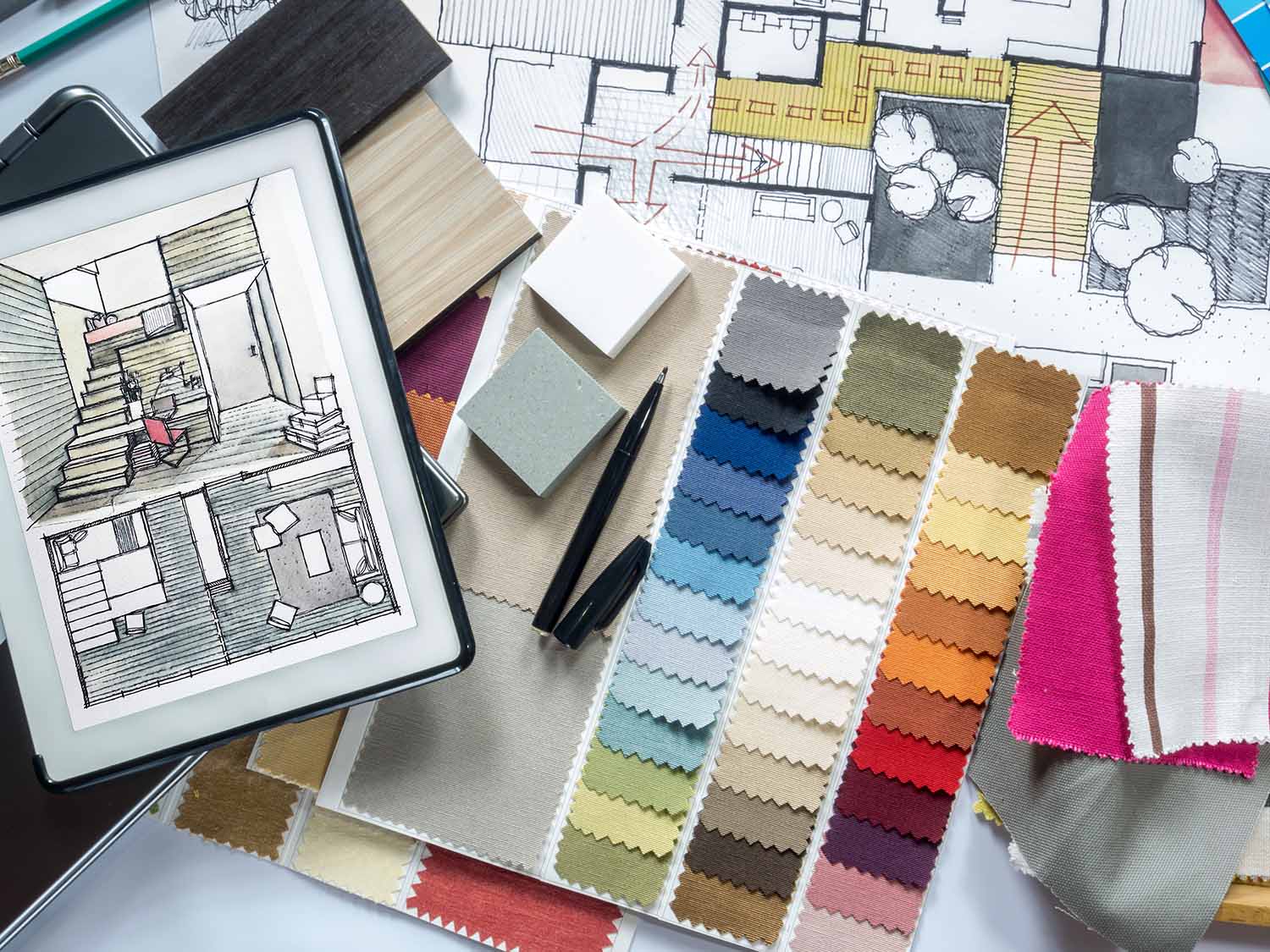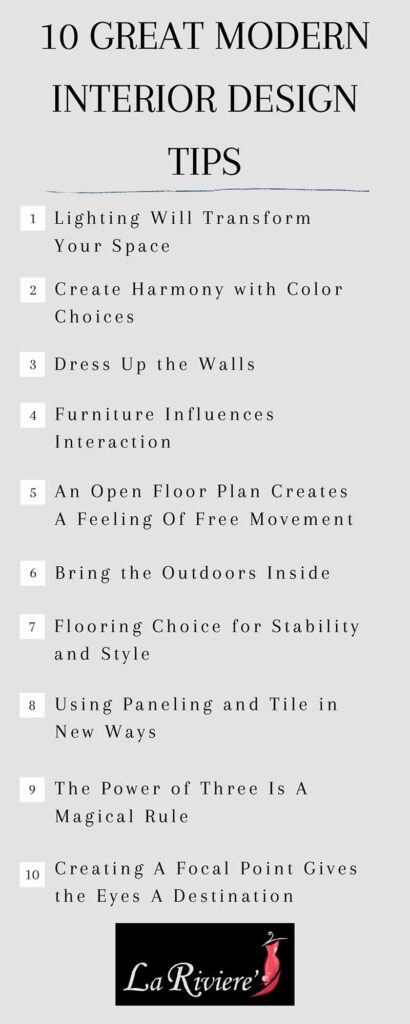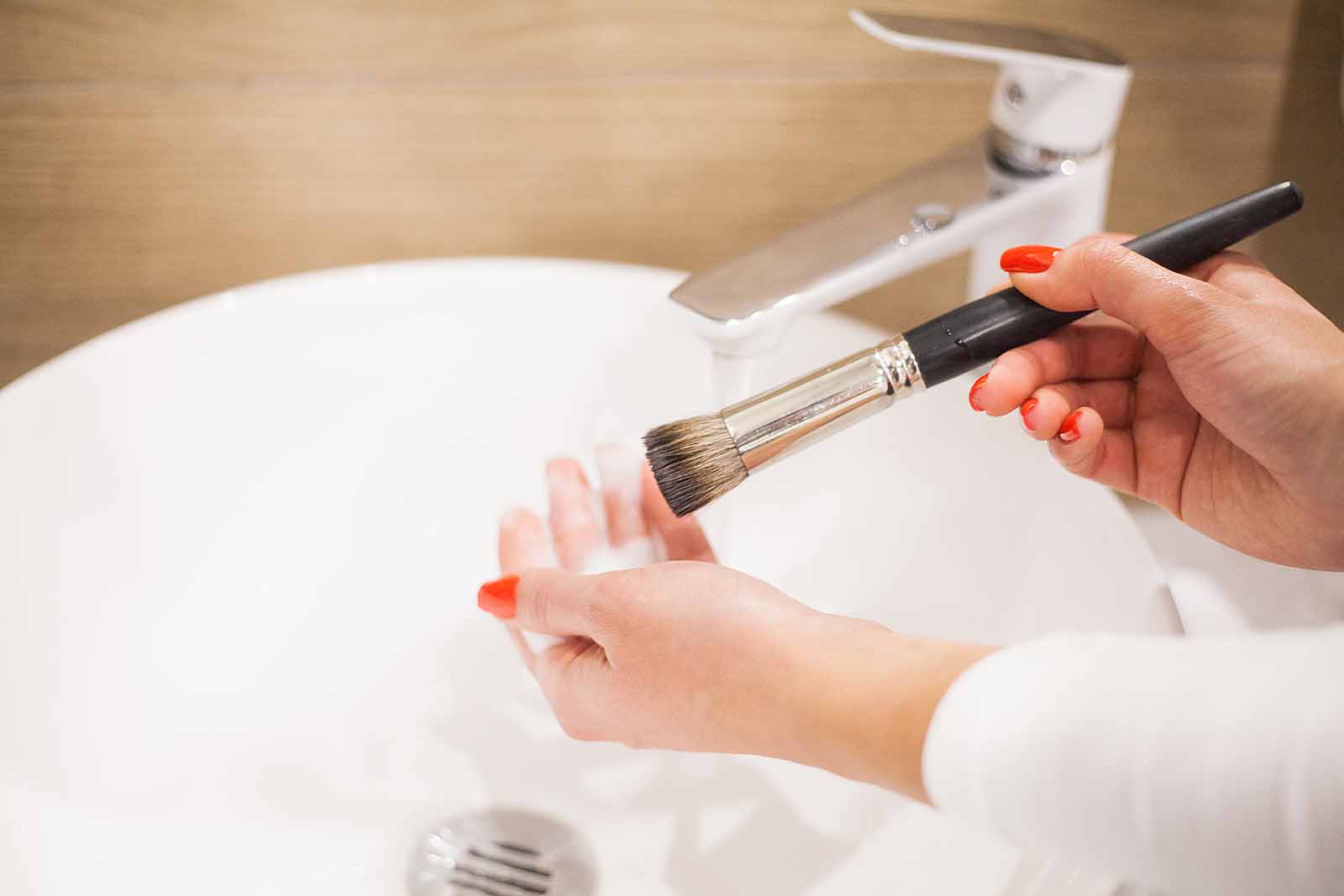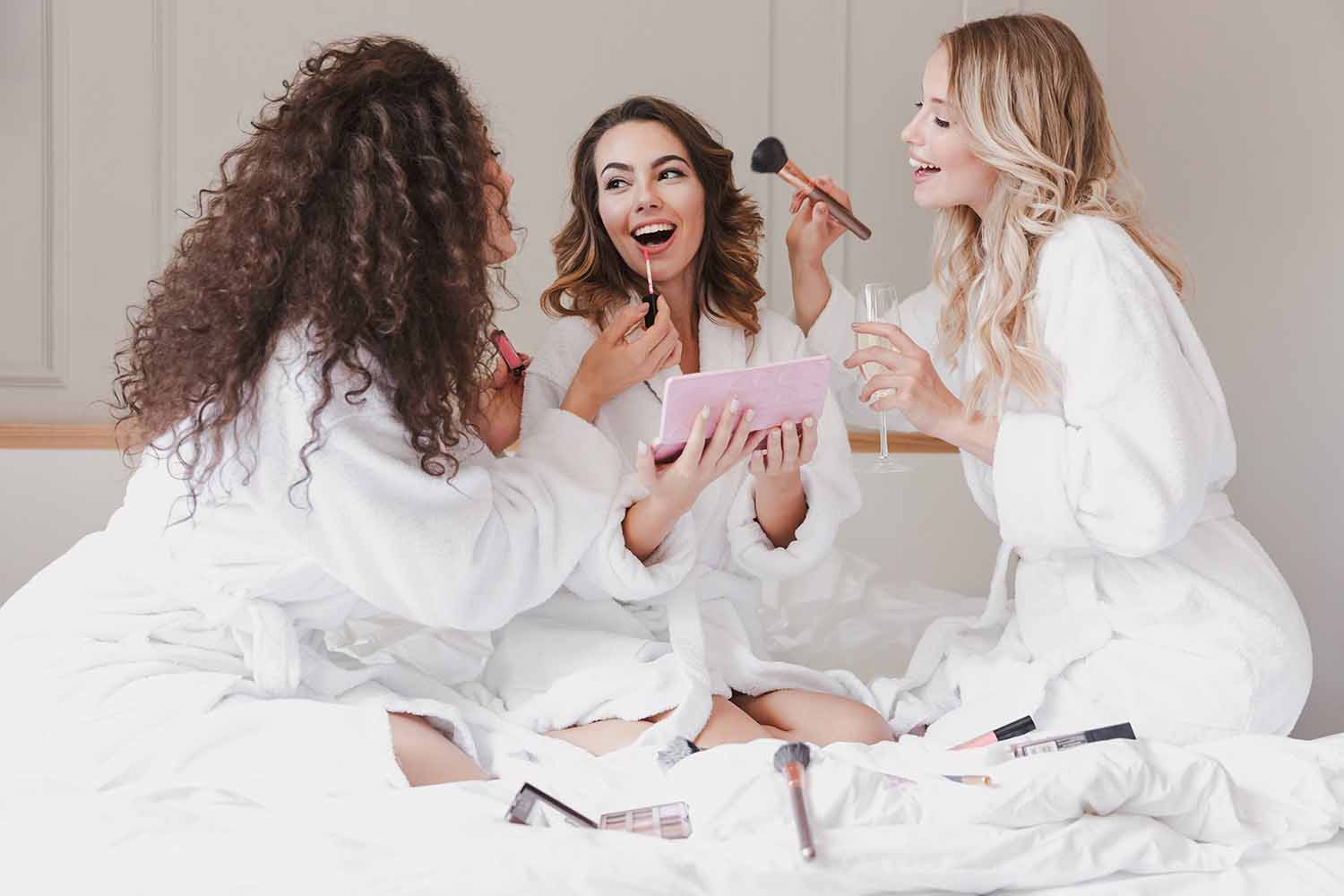10 Great Modern Interior Design Tips

Interior design can make or break a space. Design elements inside the rooms in a house can create the desired atmosphere whether that is for relaxation or engagement. Interior design in your home can be as simple as choosing decorations or furnishings that are aesthetically pleasing and flow together to create a comfortable environment.
In this article we will look at ten great modern interior design tips to enhance your space with eye-catching qualities. Here are 10 areas and tips:
- Lighting
- Color Choices
- Dressing up the walls
- Furniture layout
- An Open Floor Plan
- Plants in the home
- Flooring
- Using Paneling and Tile in New Ways
- The Power of Three
- Create A Focal Point
1. Lighting Will Transform Your Space
Choosing the right lighting for your space is more than just picking out a lamp. The right lighting will allow your eyes to better experience the textures and colors in a room. A well lit room can positively influence the mood of everyone. Poorly lit areas can cause people to feel sad or more withdrawn.
Light can change how big or small a space looks, layering different lighting elements will enhance your space. You can use light to highlight certain elements you want to stand out in a room such as art or a dark corner. Do you want the room to feel warm and cozy? Do you want to make the room seem bigger? Do you want to highlight a particular wall or piece of art?
Think in Lumens and Watts when determining how much light you may need in a room.
Lumens are how bright a light is. To find out how many lumens would be good for your space you would measure the square footage of the area you want to brighten and multiply that by 20 lumens.
Watts are how much energy a light uses. This is important to take into consideration when you are buying bulbs so they do not blow or damage your outlet. If the wattage is too high for that specific bulb it can overheat and damage the light socket. Match the watts to capacity for your socket or lower than the maximum wattage to avoid problems.
Harness As Much Natural Light As Possible
We can use natural light in opening up a space through windows or a skylight. Using natural light can help save on your electric bill and let in vitamin D from the sun’s rays. Natural light is healthy for your mood. Natural light can change at different times of the year and can make a room look or feel different. There are a few ways to amplify the use of natural light in your home.
- Mirrors
- Using mirrors in your design can help the light bounce throughout the room.
- Large Windows and Doors
- Large windows and doors can allow more natural light into the home.
- Skylight
- Mirrors
Harness As Much Natural Light As Possible
We can use natural light in opening up a space through windows or a skylight. Using natural light can help save on your electric bill and let in vitamin D from the sun’s rays. Natural light is healthy for your mood. Natural light can change at different times of the year and can make a room look or feel different. There are a few ways to amplify the use of natural light in your home.
- Mirrors
- Using mirrors in your design can help the light bounce throughout the room.
- Large Windows and Doors
- Large windows and doors can allow more natural light into the home.
- Skylight
- Mirrors
2. Create Harmony with Color Choices
Did you know that colors have powerful effects on mood? That is why choosing the right colors for your home matters. Some colors will have a relaxing effect while others can create excitement. They say home is where the heart is, a place of security and comfort and you want your color choices to reflect that.
One simple trick designers use to efficiently balance color in design is the 60-30-10 Rule. This rule suggests you use 60% as your dominant color. Your secondary color would be the 30%, and lastly the 10% is reserved for your accent or pop color.
This simple tip will stop the overuse of one particular and perhaps favored color and still allow room for more layers of shades that will all pull together into one cohesive work of art.
(Creating harmony with colors can be applied to more than just interior design. It is also useful in fashion. If you want to learn more about that, you can learn fashion design sketching!)
3. Dress Up the Walls
Don’t neglect the walls when it comes to interior design. The difference just a few simple artistic pieces can make in the overall design is huge! A piece of art or wall decoration can really pull the ebb and flow of the design together. This would involve more than just slapping on a pretty paint color or patterned wallpaper. Try Some of these fun elements to dress up a vacant wall.
- Picture collages
- Picture collages of family help not only show off your beautiful family members but add a sense of togetherness and familiarity.
- Decorative Clocks
- A wall clock doesn’t have to be basic just for telling time. Jazz it up and pick an oversized decorative wall clock! These come in many styles but the most popular are typically rustic or wrought iron.
- Art Display Gallery
- Let your inner personality and art appreciation show while providing some flair on the walls.
- Shelving
- Shelving is practical for displaying your collections and knick knacks but also adds a nice design and organizational element.
4. Furniture Influences Interaction
When furniture is set up in a way that feels or looks comforting people will naturally want to stay and relax longer. Keep elegance and comfort in mind when choosing a couch or chair for your family room.
When arranging your furniture it is important that there is balance and adequate space. Too much furniture shoved into one room can make people feel anxious and uncomfortable. Choosing furniture that matches your overall design and does not clash, can have an overall more pleasing aesthetic. Check out some of these top rated comfortable lounging furniture choices.
5. An Open Floor Plan Creates A Feeling Of Free Movement
Open floor plans are becoming more and more popular, this is because they create a feeling of roominess and space. Benefits include:
- Spacious
- Room to Rearrange as desired
- Allows More Natural light and air flow
- Creates a feeling of connection
An open floor plan leaves more room for movement which is perfect for the busy household with kids or pets running around everywhere. It is also more desirable for the everyday interior designer who loves to rearrange their living space.
An open floor plan would allow more natural light to fill a space and connect spaces together. That is why you will often see an open floor plan connecting family rooms like the living room and kitchen.
6. Bring the Outdoors Inside
People are spending more time indoors than previous years. This could be due to busy lifestyles and changes in family dynamics. One way to feel more comfortable inside is to bring nature inside the home.
Nature is soothing and comforting, which is what we want our homes to feel like. Not to mention having plants inside your home can repel certain unwanted pests and cleanse the air of toxins. Ideas for bringing nature into your home are:
7. Flooring Choice for Stability and Style
Flooring choices literally pull the design look together. Some flooring choices can make a room feel bigger while others can create a cozy feeling. Flooring goes beyond a layer of carpet over some unsightly old wooden floor.
Flooring that can make a house feel bigger adds shine and will often coordinate with the furniture or wall decor. Coordinating furniture design with the flooring does not mean exactly matching. For instance, having contrast between wooden floors and dark Iron and marble furniture is a beautiful design combination. What to look for in flooring choices:
- Easy to Maintain
- Neutral Color
- Long Lasting
- Durable
If you decide to go with hardwood flooring or something similar, don’t be afraid to splurge on a big and beautiful area rug to tie the space together. Area rugs are beneficial because they can help block off an area visually without compromising space, not to mention they are easy to clean and move as needed.
8. Design Like A Pro by Using Paneling and Tile in New Ways
When it comes to the word paneling one often thinks about the exterior of a house. Brilliant minds have brought them to a new light in the world of interior design. Spice things up a bit and use some decorative paneling to break up wall patterns or add depth and dimension to an existing wall. Some of these come as easy peel and stick tiles. This little tip will make your walls go from bland to BAM! Different types of decorative tile examples include:
Tile can also be used in decorative design schemes. Tile comes in more than the stone you may find in flooring or on bathroom walls. Be innovative and experiment in adding tile in new and unusual places in the home to add an artistic element in a modern way. Try experimenting with tile or paneling designs in some of these areas to stand out from the crowd.
- Kitchen
- Bathroom
- Fireplace
- Stair backing
- Ceiling
- Island
9. The Power of Three Is A Magical Rule
Have you ever heard of the power of three rule? That is because it works and is one of those secrets designers pull out of their pocket to create symmetry and balance in a space. Three is the perfect number, it is not too much and not too little. You will often see three candles grouped together, or maybe three pictures grouped together. This is because as strange as it may seem, things grouped in odd numbers are catchy and purposeful. Three is the magic number to avoid over decorating a space.
10. Creating A Focal Point Gives the Eyes A Destination
Finally, one thing stands out the most, and that is to create a focal point. When walking into a room one’s eyes will naturally try to find something significant to focus on and remember. Creating a focal point will draw guest’s eyes to a purposeful destination.
For many this could be a display above the fireplace. It could be the Christmas tree in the window during the holidays. Or it could be something as simple as a family collage adorning the walls. The focal point will make your space memorable and give it purpose instead of a bunch of objects and materials tossed into a room.
Modern Design Thinks Outside The Box
To keep your design skills extraordinary, think outside of the box. It is okay to let your personality unfold in your interior design with style and professionalism. Keep these modern interior design tips in your back pocket. Next time it comes to redoing a space, watch your home come to life.
(To learn more on this topic, check out these interior design courses online!)









